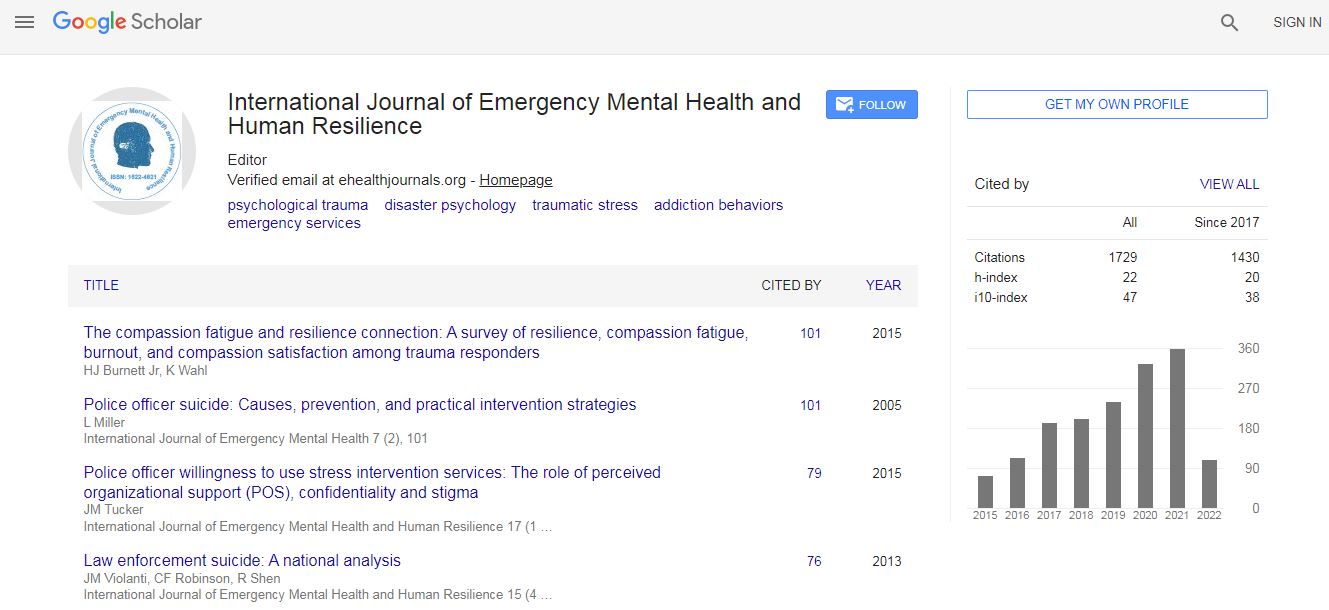Our Group organises 3000+ Global Conferenceseries Events every year across USA, Europe & Asia with support from 1000 more scientific Societies and Publishes 700+ Open Access Journals which contains over 50000 eminent personalities, reputed scientists as editorial board members.
Open Access Journals gaining more Readers and Citations
700 Journals and 15,000,000 Readers Each Journal is getting 25,000+ Readers
Google Scholar citation report
Citations : 4948
Indexed In
- Index Copernicus
- Google Scholar
- CiteFactor
- Publons
- Pubmed
- science Gate
- scispace
- world cat
Useful Links
Related Subjects
Share This Page
Exploring resilience among adolescents: analysis of three case vignettes
4th International Conference on Mental Health and Human Resilience
Vaidehi Chilwarwar and Rajani Konantambigi
Tata Institute of Social Sciences, India
ScientificTracks Abstracts: Int J Emerg Ment Health
Abstract
This paper explores the life journey of adolescents to comprehend the construct of resilience. The phenomenon of resilience was explored from three adolescents residing at a socially and economically deprived neighborhood of Janta Nagar, in Mumbai, India. A phenomenological approach was adopted to understand resilience as a subjective experience shaped by a shared identity of deprived adolescents. Purposive and snowball sampling was used to select participants. Focused group discussions were held to investigate the risk conditions among adolescents of the community. In-depth interviews were conducted to collect data that elicited information on the subjective positive outcomes. The narratives of one female and two males aged 12, 13 and 14 years were analyzed thematically. Mother├ó┬?┬?s illness, physical injury and life-threat (kidnap) were the crucial risk conditions in the lives of these adolescents, respectively. Being responsible, courageous and having aspirations were found as predominant resilient processes among the three adolescents, respectively. Individual traits of optimism, assertiveness, self-confidence, empathy and gratitude, community elements like family, bystander, and neighbors were found as crucial elements for promoting resilience factors. As a phenomenon, resilience was argued to be culturally and contextually embedded. Recent Publications: 1. Masten A S (2001) Ordinary magic: Resilience processes in development, American Psychologist 56(3):227├ó┬?┬?238. 2. Reis S M, Colbert R D and H├?┬ębert T P (2004) Understanding resilience in diverse, talented students in an urban high school. Roeper Review 27(2):110-120. 3. Ungar M (2008) Resilience across Cultures. The British Journal of Social Work, Oxford University Press. 38(2):218235. 4. Ungar M (2011) The social ecology of resilience: addressing contextual and cultural ambiguity of a nascent construct. American Journal of Orthopsychiatry 81(1):1├ó┬?┬?17. 5. Ungar M and Liebenberg L (2011) Assessing resilience across cultures using mixed methods: construction of the child and youth resilience measure. Journal of Mixed Methods 5(2):126-149Biography
Vaidehi Chilwarwar is a Research Scholar; pursuing PhD at School of Social Sciences-Tata Institute of Social Sciences. She is currently involved with studies related to resilience among adolescents. She is a Clinical Psychologist and completed Master of Philosophy from TISS in the year 2017.
Email:vaidehi.chilwarwar@gmail.com

 Spanish
Spanish  Chinese
Chinese  Russian
Russian  German
German  French
French  Japanese
Japanese  Portuguese
Portuguese  Hindi
Hindi 